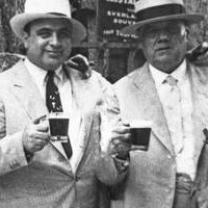Drinks, Crime and Prohibition
Drinks, Crime and Prohibition

-
Premiered:
- Network: Smithsonian
- Category: Series
- Genre: Documentary
- Type: Live Action
- Concept:
- Subject Matter: Gang/Mafia/Mob
- Tags: prohibition
Buy This Show on DVD or Watch Online
No DVDs Available
(That We Know Of)
(That We Know Of)
Legal Full Episodes
Not Available Online
(That We Know Of)
Not Available Online
(That We Know Of)
Plot Synopsis
DRINKS, CRIME & PROHIBITION is a two-part special that chronicles the legacy of Prohibition in the United States and how that era, instead of making a more sober America, weakened the nation's respect for the rule of law, enabled the expansion of organized crime, and turned city streets into battlefields. But it was also an era of great consequence, prompting federal criminal law enforcement and the expansion of the U.S. prison system.
Prohibition was an era of profound contradictions -- a period of incredible government oppression into the lives of citizens, and yet a time of exuberance, decadence, and of casting off restraints. Criminals terrorized America's streets yet captured the imagination of the public. With nearly a hundred years of hindsight, it seems like an era of madness. But the roots of Prohibition are as old as America itself. Since the beginning of the American experiment, predominantly women's religious groups preached temperance. The axe-wielding Carrie Nation, who terrorized saloons at the turn of the century, was the emblematic temperance advocate: profoundly religious and fiercely righteous. She was a member of the Women's Christian Temperance Union, the most prominent temperance organization in the country. With the outbreak of World War I, drinking beer became synonymous with treason, and the Anti-Saloon League, under the leadership of Wayne Wheeler, eclipsed the role of the Women's Christian Temperance Union and brought prohibition to the national stage. Wheeler formed an unlikely coalition of suffragettes, wealthy industrialists and nativist hate groups, and achieved what seemed impossible: a constitutional amendment against alcohol. But instead of creating a more sober America, the 1920s roared. The national ban on alcohol created unexpected opportunities for people of different genders, races and sexualities to meet and mingle in speakeasies. But institutions selling illicit alcohol were heavily segregated in one respect: class. The rich and the poor drank different drinks in different places -- and face different threats from law enforcement. Prohibition advocates thought eliminating alcohol would improve America's moral character; instead, it created an enormous opportunity for a new kind of criminal. The icon of what came to be known as organized crime was Al Capone -- a Chicago gangster whose media savvy helped him rise to ultimate power in Chicago ... and made him famous across the nation. He and other criminals capitalized on loopholes in Prohibition laws and utilized corruption & graft to amass enormous fortunes. Despite the best efforts of law enforcement to combat corruption and develop new investigative tools -- tools like code-breaking and wiretapping that are used to this day -- they were outspent and outgunned. Mobsters could afford weapons the cops cannot: weapons like the infamous Tommy gun. Capable of firing 100 rounds in under 2 minutes, it was one of the deadliest weapons money could buy. Prohibition backfired horribly. Instead of making America stronger, Prohibition turn city streets into battlefields. The ever-escalating conflict came to a head on February 14, 1929 in one of the most shocking mass murders in American history.
Smithsonian Channel premiered "Flappers and Bootleggers," Part 1 of the two-part special, on Monday, June 11, 2018 at 8pm ET/PT, followed by the finale, "Gangsters and G-Men," one week on Monday, June 18 at 8pm.
Production & Distribution
- Produced by JWM Productions
